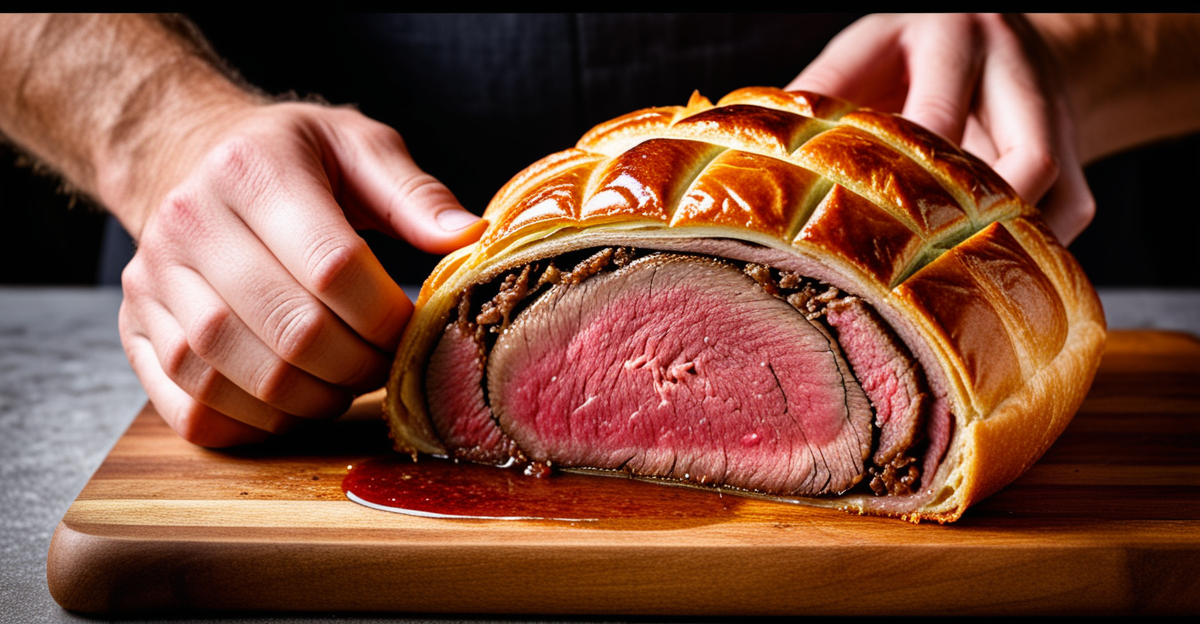Proven Methods for Preparing a Hearty Beef Wellington
Creating a truly hearty beef Wellington hinges on mastering specific preparation techniques that build robust flavour and maintain perfect texture. The step-by-step beef Wellington process starts with selecting a well-trimmed beef fillet, which should be seared to lock in juices, ensuring the core remains tender.
Central to hearty beef Wellington methods is controlling moisture. Excess liquid in the filling, notably in the duxelles—a finely chopped mushroom mixture—is a common pitfall. Reduce moisture by cooking the duxelles slowly, allowing it to develop intense earthy flavours without sogginess.
Have you seen this : What are some tips for making a delicious Welsh rarebit?
Balancing the beef, pastry, and duxelles ratios is essential. The pastry should be thick enough to hold the filling without overpowering but not so heavy it masks the beef’s richness. Meanwhile, the duxelles acts as a flavour bridge and moisture barrier. Ensuring each layer complements the others preserves the Wellington’s structural integrity and depth.
These beef Wellington techniques form a foundation. Methodical application leads to a dish boasting complex taste profiles and the satisfying heft expected of a classic, hearty beef Wellington.
Also read : How Can British Dishes Transform Your Culinary Skills?
Proven Methods for Preparing a Hearty Beef Wellington
Creating a hearty beef Wellington hinges on mastering key preparation techniques that ensure robust flavour and ideal texture throughout. The first crucial step involves selecting beef of high quality and thickness to maintain juiciness. A step-by-step beef Wellington preparation starts with searing the beef fillet to develop a rich crust, locking in moisture for tenderness.
Attention to the duxbelles is equally vital. This finely chopped mushroom mixture must be cooked down sufficiently to remove excess moisture, which prevents sogginess and promotes a concentrated earthy taste. Balancing moisture here is essential for a Wellington that feels substantial and full-bodied.
When incorporating pastry, carefully control the ratio of filling to beef. Thick layers of duxelles or pâté create a robust filling, but too much risks overpowering the meat and softening the pastry. The pastry must encapsulate the fillet tightly but not excessively thick, preserving structural integrity and a crispy finish.
Ultimately, successful hearty beef Wellington methods weave together searing, moisture control, and precise layering — each step building towards a satisfying and flavourful centerpiece that showcases balance and culinary craftsmanship with every bite.
Choosing the Best Ingredients for a Rich Beef Wellington
The foundation starts here
Selecting the right beef Wellington ingredients profoundly impacts the final dish’s depth and succulence. For the beef fillet selection, choose a cut that is uniformly thick and well-marbled, ensuring tenderness and juiciness during cooking. A premium center-cut fillet is ideal, as it cooks evenly and offers a delicate balance of lean meat and fat.
Crafting an exceptional duxelles demands fresh mushrooms finely chopped and slowly cooked to reduce moisture without losing their earthy flavour. This reduction step is crucial in beef Wellington techniques because excess moisture from the duxelles can lead to a soggy pastry. Incorporating proper moisture control here enhances the dish’s structural integrity.
Beyond mushrooms, exploring pate options like foie gras or chicken liver pâté adds an extra layer of richness, creating a heartier beef Wellington. These luxurious fillings complement the beef and duxelles, enriching flavour complexity. Choosing a high-quality, flaky pastry also contributes significantly to the mouthfeel while maintaining the ideal crispness and moisture barrier.
In summary, selecting top-tier fillet cuts, carefully preparing a flavourful duxelles, and choosing complementary pâtés and pastry are essential beef Wellington ingredients that set the stage for a truly hearty result. These deliberate choices form the backbone of successful hearty beef Wellington methods.
Proven Methods for Preparing a Hearty Beef Wellington
Mastering beef Wellington techniques requires precise control over every stage of the cooking process to achieve a truly hearty and balanced dish. A step-by-step beef Wellington approach focuses first on moisture management. Excess liquid from the duxelles or pâté can easily lead to soggy pastry and dilute flavours. Cooking the duxelles slowly reduces moisture while concentrating its earthy profile, essential for a substantial filling.
Balancing the ratio of beef, pastry, and filling is another crucial aspect. The fillet should remain the star, wrapped in enough pastry to provide structure without becoming overwhelming. Too thick pastry masks the beef’s succulence, while insufficient pastry compromises the Wellington’s integrity.
A successful Wellington depends on layering these components carefully. Even distribution of duxelles and pâté around the beef ensures consistent moisture control and flavour harmony. Adhering closely to these hearty beef Wellington methods results in a final dish that boasts robust texture, rich taste, and a satisfying heft with every bite.
Proven Methods for Preparing a Hearty Beef Wellington
To master beef Wellington techniques, start with a step-by-step beef Wellington approach focusing on moisture control and ingredient balance. A primary challenge is managing the moisture in the duxelles and fillings—overly wet layers cause soggy pastry and diminish the dish’s robustness. Slowly cooking the duxelles until it is almost dry intensifies its earthy flavour while acting as an effective moisture barrier.
Hearty beef Wellington methods require careful balancing of the beef fillet, duxelles, and pastry thickness. The beef should remain the star, so the pastry must envelop the filling snugly without being too thick, which would overshadow the meat’s succulence. Conversely, the duxelles should be ample enough to add flavour but not so heavy as to compromise the pastry’s crispness.
In implementing these techniques, pay attention to layering: apply a thin, even spread of duxelles and optional pâté over the seared beef, then wrap securely in pastry to seal in juices and prevent steam buildup. This precise assembly promotes a uniform cook, preserving the tender beef interior and yielding a hearty beef Wellington with balanced flavours and satisfying texture.
Proven Methods for Preparing a Hearty Beef Wellington
The cornerstone of effective beef Wellington techniques is meticulous moisture control, which directly influences texture and flavour. Excess moisture from fillings like the duxelles or pâté compromises the pastry’s crispness, so applying a step-by-step beef Wellington approach means slowly cooking mushrooms to evaporate water content and intensify earthiness. This is foundational among hearty beef Wellington methods because well-controlled fillings lend robust, concentrated taste without sogginess.
Balancing the components is equally critical. The proportion of beef, pastry, and filling affects not just flavour harmony but structural integrity. Overly thick pastry or excessive duxelles can overshadow the beef’s natural richness. Conversely, too little pastry risks leakage and uneven cooking. A well-calibrated ratio ensures each bite delivers pronounced beef flavour, crisp pastry, and cohesive filling texture.
Layering techniques also complement these balances. Evenly spreading duxelles and pâté around the fillet seals moisture while avoiding soggy patches. Wrapping with care maintains shape during cooking, enabling the beef Wellington to finish with a hearty yet delicate crust. Employing these hearty beef Wellington methods provides a framework for a dish that’s consistently satisfying both in flavour and presentation.
Proven Methods for Preparing a Hearty Beef Wellington
Mastering beef Wellington techniques demands strict attention to moisture control and balanced layering. A step-by-step beef Wellington approach ensures each element contributes to robust flavour and texture without overwhelming the dish. Moisture in the filling—especially within the duxelles and any pâté—requires slow, careful reduction to avoid soggy pastry, a common obstacle in hearty preparations.
Balancing ratios among beef, pastry, and duxelles is pivotal. The beef fillet must remain the centrepiece, with the pastry wrapped just thickly enough to support structure while allowing a crisp crust. Meanwhile, the duxelles acts as both a moisture barrier and flavour enhancer; applying it evenly but sparingly prevents it from overpowering the meat or softening the pastry.
Hearty beef Wellington methods also emphasise precise assembly. Spreading a thin, consistent layer of duxelles and optional pâté directly onto the seared fillet helps maintain a firm yet flavourful filling. Wrapping it securely in pastry locks in juices, promoting even cooking and a satisfying bite. Attention to these preparation steps ensures a bold, balanced Wellington that delivers richness alongside perfect texture in every mouthful.
Proven Methods for Preparing a Hearty Beef Wellington
Mastering beef Wellington techniques requires precision in every step to build robust flavour and texture. The step-by-step beef Wellington process begins with controlling moisture: excess liquid in the duxelles or pâté risks soggy pastry and muted flavours. Slowly cooking the mushroom duxelles until nearly dry intensifies its earthy taste and forms a moisture barrier. This baking foundation is critical within hearty beef Wellington methods to preserve both structure and taste.
Balancing the key components—the beef fillet, pastry, and duxelles filling—is vital. The beef should remain the star, therefore the pastry must be thick enough to hold the filling securely without overwhelming the tender meat. Similarly, the duxelles add richness but must be applied evenly and sparingly enough to avoid softening the crust. A misaligned ratio causes uneven cooking or compromised textures.
Layering is another hallmark of successful hearty beef Wellington methods. Spread a thin but complete layer of duxelles and optional pâté around the seared fillet to trap juices and prevent steam accumulation. Wrapping securely but not too tightly ensures a uniform cook and an enticing golden, flaky exterior.
By rigorously applying these beef Wellington techniques—moisture management, balanced ratios, and careful layering—you achieve a hearty dish that delivers depth, crispness, and juicy richness in every bite.
Proven Methods for Preparing a Hearty Beef Wellington
Mastering beef Wellington techniques requires a clear, step-by-step beef Wellington approach focusing on essential preparation steps that maximise robust flavour and ideal texture. Central to hearty beef Wellington methods is moisture control—slowly cooking the duxelles to remove excess liquid while concentrating its earthy profile prevents soggy pastry, which can compromise the dish’s integrity.
Balancing ratios of beef, pastry, and duxelles is critical. The beef fillet should remain the focal point, surrounded by a pastry that is thick enough to hold but thin enough to let the meat’s richness shine. A well-measured layer of duxelles provides flavour without overwhelming or softening the pastry.
Ultimately, these hearty beef Wellington methods involve precise layering and assembly. Evenly spreading the duxelles and optional pâté on the seared beef ensures consistent moisture control and flavour distribution. Wrapping tightly in pastry seals in juices and maintains the Wellington’s shape, supporting even cooking and delivering a satisfying bite every time.








